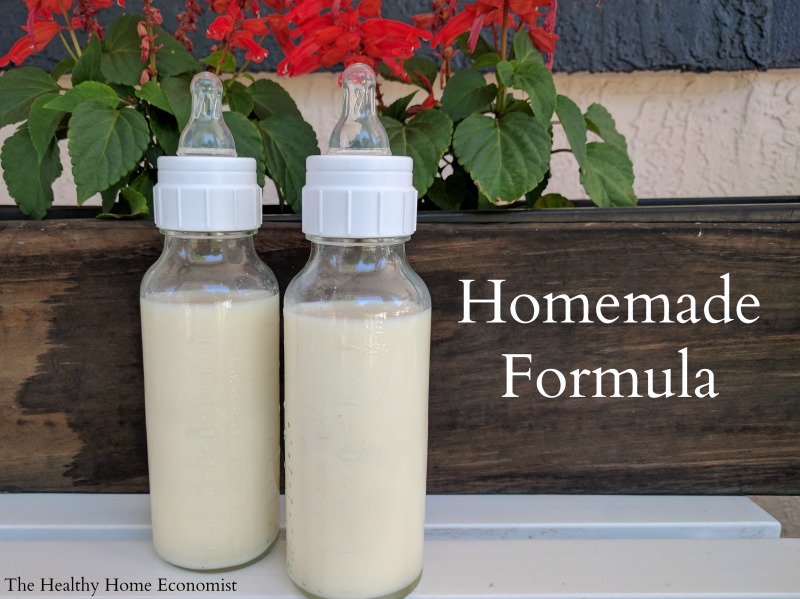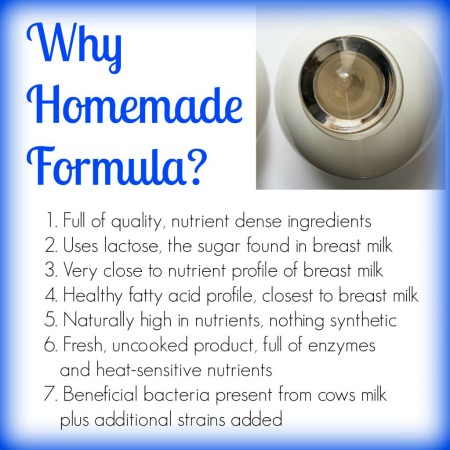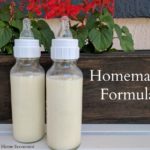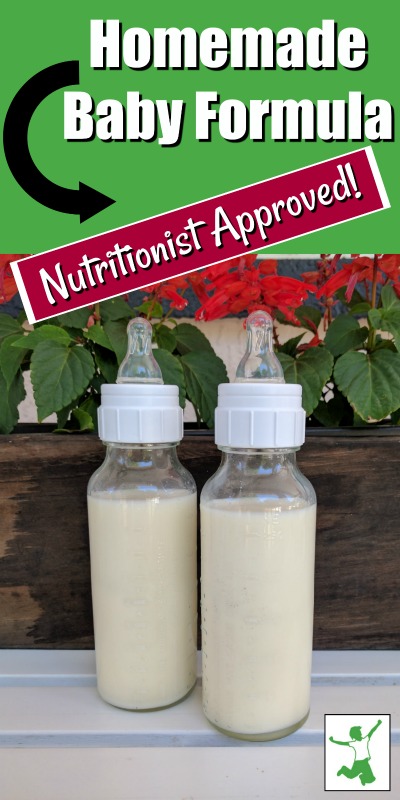Table of Contents[Hide][Show]
A nourishing homemade baby formula using safe, whole ingredients. This recipe was developed and tested by Dr. Mary Enig, a PhD Nutritionist and originally published in Nourishing Traditions cookbook in 1996. It was formulated to match breastmilk as closely as possible and is also suitable for infants. Source: Weston A. Price Foundation

There is no doubt that breastfeeding your baby is the best option for the child’s long-term health and development. Human breastmilk from a well-nourished mother is the perfect food for baby. However, in circumstances where the child is adopted or the Mother finds herself unable to breastfeed, formula feeding becomes necessary. In those cases, homemade baby formula is best.
Using a baby formula recipe that closely matches the nutritional profile of breastmilk is a far better choice than even organic baby formula from the health food store. More on this below.
Note: Donor programs are widely available for human breastmilk. But, the diets of the donor mothers are unknown and most likely nutritionally insufficient. In addition, breastmilk banks pasteurize the donated breastmilk which destroys much of the nutritional benefit. Unless you are fortunate to have a trusted and direct donor milk source in your community, avoid this option!
Dangers of Commercial Formula
Commercial formulas are always a poor choice for a number of reasons. First of all, formula manufacturers line the cans with the chemical BPA. This substance disrupts hormone development and is a probable contributor to early puberty in girls, and ADHD, urogenital abnormalities, and other ills in boys.
The European Food Safety Authority found that canned commercial formula is a significant source of BPA for infants, exposing the child to 13mcg of BPA per kg of body weight per day! BPA-free formula cans are no better. The chemical BPS is typically used instead which is just as dangerous.
Beware that manufacturers pack even organic commercial formula like Earth’s Best in BPA cans. Worse, they use organic brown rice syrup as the primary sweetener which is known to be frequently contaminated with arsenic.
In addition, all commercial milk formulas are processed at extremely high temperatures which violently denature the fragile milk proteins, render them allergenic, and add carcinogens to the final product. Soy infant formula is the worst. Obscenely high processing temperatures not only denature the proteins but large levels of phytic acid in soy block mineral absorption by the infant. Moreover, soy-based plant estrogens disrupt the hormonal development of the baby!
It seems that for the concerned Mother who is unable to breastfeed, learning how to make baby formula at home with safe, pure ingredients is the most prudent way to go!
Why Make Homemade Formula Even if You Are Breastfeeding
In the video below, I show you how to make your own safe, healthy raw milk homemade formula for your baby.
The recipe I follow was originally published in the cookbook Nourishing Traditions in 1996 and developed by Dr. Mary Enig.
Even though I breastfed each of my children for at least 2 years, I made this exact formula for my own children when I was away for the day or the evening as pumping was not an option that worked well for me.
I even used this homemade formula for an entire day once when I had some dental work done and was advised to pump and discard for 24 hours.
As a result, even successfully breastfeeding Moms can use this wonderful homemade formula as a supplement when necessary to their own nutrient-dense breastmilk!
It is advised that even breastfeeding Mothers have the ingredients for this formula on hand for an emergency. If Mom is sick or otherwise unable to nurse, Dad can step in and make this safe alternative until Mom is back on her feet. It takes a few days to a week to gather all the ingredients together to make this formula, which is why I advise having them on hand at all times.
Homemade Most Nutritious
The image below lists the reasons why it is worth it nutritionally to make formula yourself for your precious baby!
You can order all of the required ingredients for the homemade baby formula in one package from this reputable, vetted source.
Moms who have successfully used this formula feeding your children, please post about your experience in the comments section to encourage those who are considering it and need some Mom to Mom encouragement!

Where to Source Quality Milk
The most widely available grass-fed milk around the world is from cows. This is usually the most budget-friendly and easily sourced milk for this recipe for homemade formula.
If only goat milk is available in your area, this recipe for goat milk baby formula can be used instead. When using milk from ewes, please refer to the linked article for an adjusted recipe; one of the benefits of sheep milk is that it is higher in healthy fats than either goat or cow milk.
Camel milk formula is another option that is a particularly digestible form of dairy and growing in popularity around the world.
Alternatively, you can use low temp (vat) pasteurized, non-homogenized whole milk cultured with a piima or kefir starter. Then substitute the piima milk or kefir for the raw milk portion of the formula recipe. Cold-pressed raw milk also must be cultured before using it as it contains no probiotics.
Do NOT use ultrapasteurized (UHT) milk even if organic as it is too highly processed and extremely allergenic!
It is also best to avoid all types of powdered milk for this recipe. The factory process of making milk powder reduces nutrition considerably and denatures it, which makes it more likely baby will have an allergic reaction.
Dairy Allergy Option
If all types of dairy prove unsuitable for your baby, make this nondairy baby formula recipe instead. It uses a base of homemade bone broth as a substitute for milk. It is important not to utilize a plant-based or otherwise vegan baby formula recipe.
Avoid buying bone broth to make the dairy-free formula. Make it yourself! Manufacturers of commercial bone broth, even if authentic, may water down the end product. This is apparent if it does not gel when chilled in the refrigerator.
Many brands have toxic packaging issues as well. If you must buy it in a pinch, see my shopping guide page for vetted brands that are safe.

Homemade Baby Formula Recipe (for infants too)
A nourishing baby formula recipe you can make at home with safe, whole ingredients developed and tested by a PhD nutritionist to match breastmilk as closely as possible. Also suitable for infants.
Ingredients
- 2 cups raw cow milk OR organic whole milk yogurt
- 1 7/8 cups filtered water
- 1/4 cup liquid whey
- 4 Tbl lactose
- 1/4 tsp Bifidobacterium infantis powder
- 2-4 Tbl raw or pasteurized cream
- 1/2 tsp cod liver oil unflavored
- 1/4 tsp butter oil unflavored
- 1 tsp sunflower oil preferably organic
- 1 tsp extra virgin olive oil preferably organic
- 2 tsp virgin coconut oil preferably organic
- 2 tsp nutritional yeast
- 2 tsp gelatin
- 1/4 tsp acerola powder
Instructions
-
Fill a 2 cup Pyrex measuring cup with filtered water and remove 2 TBL (this will give you 1 7/8 cup water).
-
Pour about half the water into a pan and turn burner on medium.
-
Add the gelatin and lactose and let dissolve, stirring occasionally.
-
When gelatin and lactose are dissolved, remove pan from heat and add the rest of the water to cool.
-
Stir in the coconut oil and butter oil until melted.
-
Put remaining ingredients in a glass blender.
-
Add the water mixture and blend for about 3 seconds.
-
Place formula in glass baby bottles or a glass jar and refrigerate.
-
Before giving to baby, warm glass bottle in a pan of hot water or a bottle warmer. NEVER microwave baby bottles!
Recipe Video
Recipe Notes
If using raw cow milk from holstein cows, use 4 Tbl of extra cream (otherwise use 2 Tbl extra cream).
If choosing to make this homemade formula with camel milk, be sure to include 4 Tbl extra cream as camel milk is lower in cream than cow milk.
Do not use high oleic sunflower oil. Use only the brand recommended in the ingredients list which is cold pressed, organic, unrefined, and low oleic.
*Do NOT use powdered whey from the store as it is denatured. Avoid whey from making cheese as it will curdle the formula.
*Do not substitute pasteurized or powdered milk as these are heavily processed, denatured and allergenic foods.
*Do NOT use ultrapasteurized (UHT) cream. It is highly allergenic. Raw or pasteurized cream is acceptable.
*Do NOT use fish oil or krill oil instead of high vitamin cod liver oil as they do not contain any Vitamin D and very little to no Vitamin A.
Collagen powder may be substituted for the gelatin in a pinch (more on peptides in baby formula in this article).
If you are wondering where is the iron in homemade baby formula, this article provides an explanation.
If baby experiences constipation using this formula, try adding 1 tsp of molasses to each batch. This should help move things along.
How to Transition to DIY Formula
Once you’ve viewed the video, gathered the ingredients, and made your first batch, how do you feed it to your baby for the first time?
It is important not to switch all at once as this can cause gas, excessive spit-up, or an uncomfortable change in diaper habits such as constipation or overly loose stools.
Start by giving your baby three-quarters of the old formula blended with one-quarter of the homemade. Try this ratio for a day or two and see how your infant responds.
If no digestive upset or major change in diaper habits occurs, increase the amount to a 50-50 blend of old formula to homemade. Observe for another day or two as before.
If no major issues, increase once again to three-quarters homemade formula to one-quarter old formula. If baby does well on this blend for a third time, you are ready to fully transition to the homemade formula.
At any time during the transition, symptoms of intolerance emerge, back up to the previous successful blend ratio and stay there for a day or two before attempting to increase once again.
Homemade Formula FAQ
Weston Price Foundation
Feeding an Adopted Baby
Traveling Tips with Baby Formula Made at Home
Iron in Baby Formula
Collagen Peptides instead of Gelatin for Homemade Formula?










I would like to see the research to back up your statement that poor maternal diet has shown a difference in breastmilk quality! I am studying to be a Lactation Consultant and have never seen such research. All the research I have seen shows quite the opposite in fact.The malnourished mother can produce a very good breastmilk, it would be at her expense but the baby would not suffer at all. This is disturbing to me that such myths are being put out there.There is a very telling photograph that UNICEF has in their information sheets of a very poor, under nourished Indian mother who breastfed one twin and formula fed the other..the photograph is very shocking as the breastfed baby is healthy and gaining well and the formula fed baby is very skinny adn actually died a few days after the photograph was taken.
This is a handout by Dr Jack Newman, a world respected Pediatrician who specialises in Lactation. Page 2 sections 1 and 2 address this issue.
Hi Helen, I posted a link in the above comments that refers to a number of studies outlining this very fact that diet greatly affects breastmilk quality. I'm not saying that the breastmilk of that Indian mother is not as good as commercial formula (which is complete garbage – I think we can agree on that) .. I'm saying its not as good as a quality homemade formula such as what I show in the videoblog.
I would disagree that "most" breastfeeding moms eat healthy. Pretty much anyone shopping for food at a grocery store, even Whole Foods is not eating healthy because even the "fresh" food is processed and chemically bathed. Animal products need to be pasture fed and dairy products need to be raw and rarely are they available in that form at the stores, at least where I live. Thankfully we have access to a local dairy and can get our milk, cheese and cream raw. Fresh fruits and veggies even organic ones are picked so early and some are artificially ripened so they have a shipping/shelf life, but because they are off the vine they can not get the minerals they need from the soil, so they are deficient as well. Pediatricians and MDs are the last people you want to go for advice on Nutrition. They get their information from the government who is the one responsible for destroying our food industry in the first place. Cheap Convenient food = Disease
Amen to that!
Thumbs up to mamabear023 with great critical thinking skills!!
Hi Stephanie, that is a great question! I suspect that the warning about cow's milk before one year old has much to do with the fact that the milk that is warned about is pasteurized or ultra-pasteurized. Pasteurizing of milk denatures the fragile milk proteins and makes an allergenic reaction much more likely for a child so young which is why this formula recommends clean certified raw milk or low temp pastueurized, nonhomogenized milk that has been cultured back to life with good bacteria like kefir or piima starter.
This post was much needed. I just gave a friend my Nourishing Traditions cookbook so she could make her own formula. I am getting all the ingredients tomorrow to keep for a backup. Thanks for this post.
Hi Sarah, I am curious why the recipe calls for cows milk, but everyone always says babies can't have cows milk till they are at least 1 year old. I don't get it??
And also, like someone mentioned at the top, if you find a local mom to donate breastmilk to you that is the next best thing, the milk and is fresh and straight from the cow….er, I mean Mama, so no paturization needed.
I have had to exclusively pump for my daughter due some phsyical problems she had that made nursing impossible for us and thankfully my supply has been fantastic this whole time. I have donated milk to 5 other babies in my town. Two of them, were still breastfeeding, but were skinny and their mothers asked me for my good, fatty milk to fatten them up! 🙂
commercial formula is made from cow’s milk too. you have to start somewhere if you are making formula. but it is important to use the raw milk. it is extremely rare for allergies or irritations to develop with raw milk.
Respectfully I can say that for me what is common sense is that God designed cow's milk to feed baby cows and human milk to feed baby humans. I also understand that yes humans can screw even this up but I don't believe it's to this extreme and other factors may be involved then just diet. I skimmed over those studies and there's one factor I didn't see really mentioned, the environment. How do vaccinations, air conditions, etc come into play with those studies mentioned? Especially, the cancer study.
However, I hope I don't sound like I'm advocating a mother to just pig out on whatever food she desires…but if I had a choice between donated milk from a mother who may not eat exactly according to my standards and formula, I'm pretty sure I'd choose breastmilk. I do consider myself a fairly healthy eater but I wouldn't say that I eat as healthy as Sarah, so would my breastmilk be considered insufficient? I suppose I'm confused on these standards and I guess at this point I'd have to admit that I have my own…I wouldn't want donated milk from a smoker or a drinker.
I do agree with you (Anonymous) that unpasteurized breastmilk from a trusted source would be better than the homemade formula. I just don't think this option would materialize in the vast majority of cases for women which is why I thought it important to get this info out there in a video so Moms know there is a healthy option to commercial formula.
In response to our question about the nutrition in the homemade formula, here is a link on that:
http://www.realmilk.com/formularecipes.html#chart
Sarah, it is unfortunate that “banked” human breastmilk is not more affordable, and not more readily available. I’m glad and thankful you offered this recipe, and it looks like its a better product than the dead powdered stuff in a can.
Very useful post.
Also have you looked at iherb.com or swansonvitamins…they offer many of those products you linked to on amazon for WAY less.
The now Lactose is only 3.54 on iherb
http://www.iherb.com/Now-Foods-Lactose-Milk-Sugar-1-lb-454-g/657?at=0
Here is a $5 coupon off your first order NEW344
Great video about making formula, I think it can be very helpful, but has anyone input this into a nutritional calculator to see what the actual nutritional output is, that would be nice to see and compare to commercial formula….
however, I have to say I do not agree with this from the article…this sounds too far fetched and not enough data to back it up, because we can clearly see that many moms don't eat well but still breastfeed healthy kids. All this sounds way to much like someone AGAINST breastfeeding and PRO formula.
""A study published in July, 2001, for example, found that breastfed children in Japan had more asthma than bottle-fed infants.1… Those with the best iron status were those who received iron-fortified formula.2…. A study from Norway found that breastfeeding did not provide protection against frequent ear infections.4 A report in Pediatric Clinics of North America noted that many breastfed babies suffer from failure-to-thrive and dehydration.5 The author warned: "Those who enthusiastically promoted breastfeeding for its many health benefits must confront the reality of breastfeeding failure and implement necessary changes in medical education and support services to foster successful outcomes in breastfed infants…… ""
failure to thrive? That is not due to poor breastmilk quality but not breastfeeding PROPERLY. (scheduled feeding is highly promoted in hospitals, 4 hour feedings for newborns! When bm digests in a matter of 20-30 minutes! we just shove a pacifier in their mouths for 3 hours)
I'll have to see if I can find some of the information, but I have always read that breastmilk will actually first take away from the mom while providing the child with the nutrients they need. Then if a mom isn't eating/drinking enough, they will lose their supply because the body can't keep up, all though there are those outside the range. Nature (and God) would want our young to survive to carry on our species, even in "tough times".
The fat content (cream) is not the only thing that determines the health of a mother's milk.
I believe that a traditional diet for a child would be breastfeeding only for the first YEAR and then slowly introducing foods that the baby can pick up and eat themselves rather than mashing up foods and spoon feeding them at 4 and 5 months old (THAT is not healthy nor normal) or traditional for that matter. I just don't think it is that cut and dry, a lot of the things those studies mentioned (cancer, ear infections etc..) aren't "cured" or prevented by being breastfed, The link is in vaccines and chemicals in our foods and environment causing them, but being breastfed certainly makes a child healthier from getting diseases compared to a non breastfed non vaccinated child. I think those studies are comparing apples to oranges and missing over a huge point, breast milk alone isn't the only part of the equation of whether a child is "healthy".
ok, I probably just rambled and didn't make any sense at all. I still think this formula could be a good thing for many, but I personally would give (unpasteurized) donor human milk (from a trusted source) before the formula or at least in conjunction with it. I still think there are millions of beneficial properties still there regardless if it may be lacking in a few areas. There is also proof that even the pasteurized donor milk from milk banks used for preemies in NICU's across the world, saves lives compared to giving those babies commercial formula.